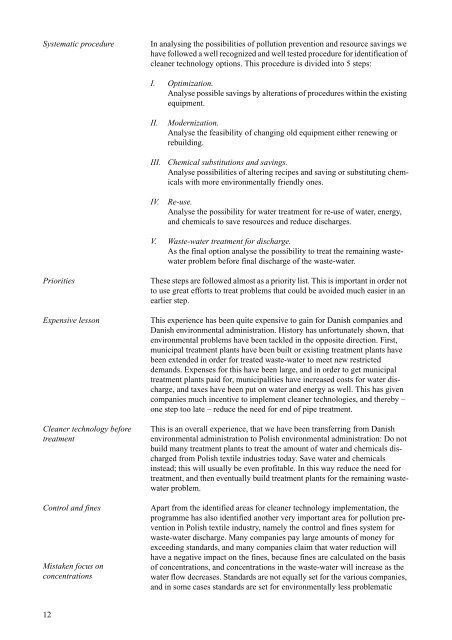Cleaner Technology Transfer to the Polish Textile ... - Miljøstyrelsen
Cleaner Technology Transfer to the Polish Textile ... - Miljøstyrelsen
Cleaner Technology Transfer to the Polish Textile ... - Miljøstyrelsen
You also want an ePaper? Increase the reach of your titles
YUMPU automatically turns print PDFs into web optimized ePapers that Google loves.
Systematic procedure In analysing <strong>the</strong> possibilities of pollution prevention and resource savings we<br />
have followed a well recognized and well tested procedure for identification of<br />
cleaner technology options. This procedure is divided in<strong>to</strong> 5 steps:<br />
12<br />
I. Optimization.<br />
Analyse possible savings by alterations of procedures within <strong>the</strong> existing<br />
equipment.<br />
II. Modernization.<br />
Analyse <strong>the</strong> feasibility of changing old equipment ei<strong>the</strong>r renewing or<br />
rebuilding.<br />
III. Chemical substitutions and savings.<br />
Analyse possibilities of altering recipes and saving or substituting chemicals<br />
with more environmentally friendly ones.<br />
IV. Re-use.<br />
Analyse <strong>the</strong> possibility for water treatment for re-use of water, energy,<br />
and chemicals <strong>to</strong> save resources and reduce discharges.<br />
V. Waste-water treatment for discharge.<br />
As <strong>the</strong> final option analyse <strong>the</strong> possibility <strong>to</strong> treat <strong>the</strong> remaining wastewater<br />
problem before final discharge of <strong>the</strong> waste-water.<br />
Priorities These steps are followed almost as a priority list. This is important in order not<br />
<strong>to</strong> use great efforts <strong>to</strong> treat problems that could be avoided much easier in an<br />
earlier step.<br />
Expensive lesson This experience has been quite expensive <strong>to</strong> gain for Danish companies and<br />
Danish environmental administration. His<strong>to</strong>ry has unfortunately shown, that<br />
environmental problems have been tackled in <strong>the</strong> opposite direction. First,<br />
municipal treatment plants have been built or existing treatment plants have<br />
been extended in order for treated waste-water <strong>to</strong> meet new restricted<br />
demands. Expenses for this have been large, and in order <strong>to</strong> get municipal<br />
treatment plants paid for, municipalities have increased costs for water discharge,<br />
and taxes have been put on water and energy as well. This has given<br />
companies much incentive <strong>to</strong> implement cleaner technologies, and <strong>the</strong>reby –<br />
one step <strong>to</strong>o late – reduce <strong>the</strong> need for end of pipe treatment.<br />
<strong>Cleaner</strong> technology before<br />
treatment<br />
This is an overall experience, that we have been transferring from Danish<br />
environmental administration <strong>to</strong> <strong>Polish</strong> environmental administration: Do not<br />
build many treatment plants <strong>to</strong> treat <strong>the</strong> amount of water and chemicals discharged<br />
from <strong>Polish</strong> textile industries <strong>to</strong>day. Save water and chemicals<br />
instead; this will usually be even profitable. In this way reduce <strong>the</strong> need for<br />
treatment, and <strong>the</strong>n eventually build treatment plants for <strong>the</strong> remaining wastewater<br />
problem.<br />
Control and fines Apart from <strong>the</strong> identified areas for cleaner technology implementation, <strong>the</strong><br />
programme has also identified ano<strong>the</strong>r very important area for pollution prevention<br />
in <strong>Polish</strong> textile industry, namely <strong>the</strong> control and fines system for<br />
waste-water discharge. Many companies pay large amounts of money for<br />
exceeding standards, and many companies claim that water reduction will<br />
Mistaken focus on<br />
concentrations<br />
have a negative impact on <strong>the</strong> fines, because fines are calculated on <strong>the</strong> basis<br />
of concentrations, and concentrations in <strong>the</strong> waste-water will increase as <strong>the</strong><br />
water flow decreases. Standards are not equally set for <strong>the</strong> various companies,<br />
and in some cases standards are set for environmentally less problematic

















